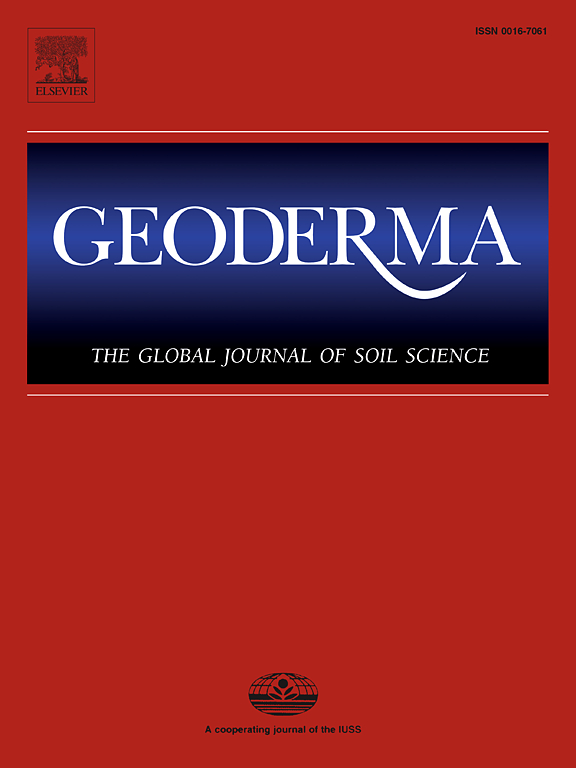Kinetics of element release by weathering in soils of southern Ecuador: A comparison among different climatic and land-use regimes
IF 5.6
1区 农林科学
Q1 SOIL SCIENCE
引用次数: 0
Abstract
To predict future changes in nutrient availability in the young soils of the tropical Andes, it is important to study the response of weathering rates to climate and land-use change. This is particularly true in highly biodiverse tropical forests, where increasing nutrient availability can threaten their biodiversity. Hence, our objectives were to compare the kinetics of element release by weathering along an elevation gradient and between forest and pasture in a tropical montane forest region in south Ecuador. We collected soil samples from three plots in both natural forest and pasture, at elevations of 1000, 2000, and 3000 m above sea level (a.s.l., i.e., 18 in total). The sites at 2000 and 3000 m a.s.l. had similar parent material and allowed for evaluating the climatic effect. To assess element mobilization from the soil, we conducted a weathering experiment at a constant pH value (pHstat). During the experiment, ions were released from the soil into solution at pH 3 and removed from the solution using an ion-exchange resin. We described the release of base cations (Ca, Mg, K), Mn, Al, and Fe with a two-step first-order reaction, distinguishing a fast-reacting pool (FP) and a slow-reacting pool (SP), with their associated rate constants. The FP of Ca, Mg, K, and Mn closely correlated with and corresponded in size to the concentrations of the exchangeable cations of these elements (r = 0.78 – 0.96). The FP of Ca, Mg, K, and Mn was significantly larger in the soils under pasture than under forest vegetation, likely because of the input of alkaline ashes during slash-and-burn practices. The sizes of the FP and the SP of all studied elements under both land covers/uses were not significantly different between the sites at 2000 and 3000 m a.s.l., possibly because the opposing effects of increasing precipitation and decreasing temperature canceled each other out. Metal release kinetics differed markedly among sites with different parent materials, indicating that weathering is strongly influenced by the chemical composition of the parent rocks. Our study illustrates that element release by weathering in the soils of south Ecuador is strongly influenced by differences in land cover/use and chemical composition of parent rocks.
元素释放动力学的风化在厄瓜多尔南部的土壤:不同的气候和土地利用制度的比较
为了预测热带安第斯山脉年轻土壤养分有效性的未来变化,研究风化速率对气候和土地利用变化的响应是很重要的。在生物多样性高度丰富的热带森林中尤其如此,那里不断增加的养分供应可能威胁到其生物多样性。因此,我们的目标是比较厄瓜多尔南部热带山地森林地区沿海拔梯度和森林与牧场之间的风化过程中元素释放的动力学。我们在海拔1000、2000和3000 m的天然森林和牧场中采集了3个样地的土壤样本(a.s.l,即总共18个样地)。海拔2000米和3000米的地点具有相似的母质,可以评估气候影响。为了评估土壤中元素的迁移,我们在恒定pH值(pHstat)下进行了风化实验。在实验过程中,离子从土壤中释放到pH为3的溶液中,并用离子交换树脂从溶液中去除。我们描述了碱离子(Ca, Mg, K), Mn, Al和Fe的释放,这是一个两步一级反应,区分了快速反应池(FP)和慢反应池(SP),以及它们相关的速率常数。Ca、Mg、K、Mn的FP与这些元素的交换阳离子浓度密切相关,且在大小上对应(r = 0.78 ~ 0.96)。草地土壤中Ca、Mg、K和Mn的FP显著高于森林植被,这可能与刀耕火种过程中碱灰的输入有关。两种土地覆被/利用方式下各要素的FP和SP的大小在2000和3000 m a.s.l时差异不显著,这可能是由于降水增加和气温下降的相反效应相互抵消的结果。不同母质地点金属释放动力学差异显著,表明风化作用受母质岩石化学成分的强烈影响。我们的研究表明,厄瓜多尔南部土壤中的风化元素释放受到土地覆盖/利用和母岩化学成分差异的强烈影响。
本文章由计算机程序翻译,如有差异,请以英文原文为准。
求助全文
约1分钟内获得全文
求助全文
来源期刊

Geoderma
农林科学-土壤科学
CiteScore
11.80
自引率
6.60%
发文量
597
审稿时长
58 days
期刊介绍:
Geoderma - the global journal of soil science - welcomes authors, readers and soil research from all parts of the world, encourages worldwide soil studies, and embraces all aspects of soil science and its associated pedagogy. The journal particularly welcomes interdisciplinary work focusing on dynamic soil processes and functions across space and time.
 求助内容:
求助内容: 应助结果提醒方式:
应助结果提醒方式:


